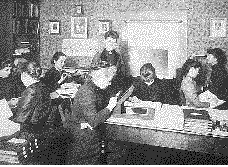| A large portion of the early research in observational astronomy focused on monitoring stellar luminosities and analyzing stellar spectra. Much of this pioneering work was done using photographic methods. What is not so well known is that most of the labor was accomplished by women. Around the turn of the twentieth century, a few dozen dedicated women—assistants at the Harvard College Observatory—created an enormous data base by observing, sorting, measuring, and cataloging photographic information that helped form the foundation of modern astronomy. Some of them went far beyond their duties in the lab to make several of the basic astronomical discoveries often taken for granted today.
This 1910 photograph shows several of those women carefully examining star images and measuring variations in luminosity or wavelengths of spectral lines. In the cramped quarters of the Harvard Observatory these women inspected image after image to collect a vast body of data on hundreds of thousands of stars. Note the plot of stellar luminosity changes pasted on the wall at the left. The cyclical pattern is so regular that it likely belongs to a Cepheid variable. Known as "computers" (there were no electronic devices then), these women were paid 25 cents an hour.
Beginning in 1880, these workers started a survey of the skies that would be carried on for a century. Their first major accomplishment was a |
catalog of the brightnesses and spectra of tens of thousands of stars, published in 1890 under the direction of Williamina Fleming. On the basis of this compilation, several of these women made fundamental contributions to astronomy. In 1897 Antonia Maury undertook the most detailed study of stellar spectra to that time, enabling Hertzsprung and Russell independently to develop what is now called the H—R diagram. In 1898 Annie Cannon proposed the spectral classification system (described in Chapter 17) that is now the international standard for categorizing stars.  (Sec. 17.6) In 1908 Henrietta Leavitt discovered the period—luminosity relationship for Cepheid variable stars, which later allowed astronomers to recognize our Sun's true position in our Galaxy, as well as our Galaxy's true place in the universe. (Sec. 17.6) In 1908 Henrietta Leavitt discovered the period—luminosity relationship for Cepheid variable stars, which later allowed astronomers to recognize our Sun's true position in our Galaxy, as well as our Galaxy's true place in the universe.

|